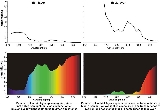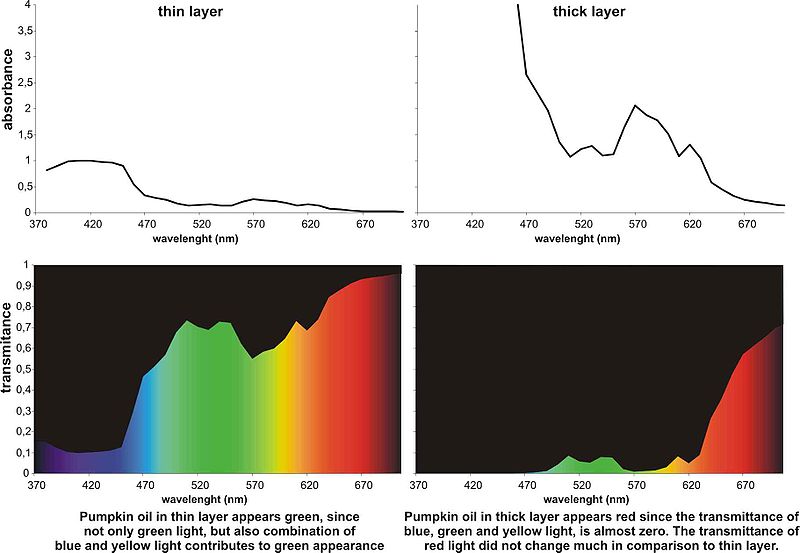
Dichromatism
Encyclopedia
Dichromatism is a phenomenon where the hue
of the colour in materials or solutions are dependent on both the concentration of the absorbing substance and the depth or thickness of the medium traversed. In most substances which are not dichromatic, only the brightness and saturation of the colour depend on their concentration and layer thickness.
Examples of dichromatic substances are pumpkin seed oil
, bromophenol blue
and resazurin
.
When the layer of pumpkin seed oil is less than 0.7 mm thick, the oil appears bright green, and in layer thicker than this, it appears bright red.
The phenomenon is related to both the physical chemistry properties of the substance and the physiological response of the human visual system
to colour. This combined physicochemical–physiological basis was first explained in 2007.
and by the excitation characteristics of the three types of cone photoreceptors in the human retina
. Dichromatism is potentially observable in any substance that has an absorption spectrum with one wide but shallow local minimum and one narrow but deep local minimum. The apparent width of the deep minimum may also be limited by the end of the visible range of human eye; in this case, the true full width may not necessarily be narrow. As the thickness of the substance increases, the perceived hue changes from that defined by the position of the wide-but-shallow minimum (in thin layers) to the hue of the deep-but-narrow minimum (in thick layers).
The absorbance spectrum of pumpkin seed oil has the wide-but-shallow minimum in the green region of the spectrum and deep local minimum in the red region. In thin layers, the absorption at any specific green wavelength is not as low as it is for the red minimum, but a broader band of greenish wavelengths are transmitted, and hence the overall appearance is green. The effect is enhanced by the greater sensitivity to green of the photoreceptors in the human eye, and the narrowing of the red transmittance band by the long-wavelength limit of cone photoreceptor sensitivity.
According to the Beer-Lambert law, when viewing through the coloured substance (and thus ignoring reflection), the proportion of light transmitted at a given wavelength, T, decreases exponentially with thickness t, T = e-at, where a is the absorbance at that wavelength. Let Ge-aGt be the green transmittance and Re-aRt be the red transmittance. The ratio of the two transmitted intensities is then (G/R)e(aR-aG)t. If the red absorbance is less than the green, then as the thickness t increases, so does the ratio of red to green transmitted light, which causes the apparent hue of the colour to switch from green to red.

(DI). It is defined as the difference in hue
angle (Δhab) between the colour of the sample at the dilution, where the chroma
(colour saturation) is maximal and the colour of four times more diluted (or thinner) and four times more concentrated (or thicker) sample. The two hue angle differences are called dichromaticity index towards lighter (Kreft's DIL) and
dichromaticity index towards darker (Kreft's DID) respectively. Kreft's dichromaticity index DIL and DID for pumpkin oil, which is one of the most dichromatic substances, are −9 and −44, respectively. This means that pumpkin oil changes its colour from green-yellow to orange-red (for 44 degrees
in Lab colour space) when the thickness of the observed layer is increased from cca 0.5 mm to 2 mm; and it changes slightly towards green (for 9 degrees) if its thickness is reduced for 4-fold.
(1738–1822), shows he observed dichromatism with a solution of ferrous sulphate in 1801 when working on an early solar telescope
, but he did not recognise the effect.
Hue
Hue is one of the main properties of a color, defined technically , as "the degree to which a stimulus can be describedas similar to or different from stimuli that are described as red, green, blue, and yellow,"...
of the colour in materials or solutions are dependent on both the concentration of the absorbing substance and the depth or thickness of the medium traversed. In most substances which are not dichromatic, only the brightness and saturation of the colour depend on their concentration and layer thickness.
Examples of dichromatic substances are pumpkin seed oil
Pumpkin seed oil
Pumpkin seed oil , a culinary specialty of south eastern Austria , eastern Slovenia , north western Croatia Pumpkin seed oil (Kernöl or Kürbiskernöl in German, bučno olje in Slovenian, bučino ulje or bundevino ulje in Croatian, and tökmag-olaj in Hungarian), a culinary specialty of south eastern...
, bromophenol blue
Bromophenol blue
Bromophenol blue is used as an acid-base indicator, a color marker and a dye.-Acid-base indicator:As an acid-base indicator its useful range lies between pH 3.0 and 4.6...
and resazurin
Resazurin
Resazurin is a blue dye, itself nonfluorescent until it is reduced to the pink colored and highly red fluorescent resorufin. It is used mainly as an oxidation-reduction indicator in cell viability assays for bacteria and mammalian cells...
.
When the layer of pumpkin seed oil is less than 0.7 mm thick, the oil appears bright green, and in layer thicker than this, it appears bright red.
The phenomenon is related to both the physical chemistry properties of the substance and the physiological response of the human visual system
Visual system
The visual system is the part of the central nervous system which enables organisms to process visual detail, as well as enabling several non-image forming photoresponse functions. It interprets information from visible light to build a representation of the surrounding world...
to colour. This combined physicochemical–physiological basis was first explained in 2007.
Physical explanation
Dichromatic properties can be explained by the Beer-Lambert lawBeer-Lambert law
In optics, the Beer–Lambert law, also known as Beer's law or the Lambert–Beer law or the Beer–Lambert–Bouguer law relates the absorption of light to the properties of the material through which the light is travelling.-Equations:The law states that there is a logarithmic dependence between the...
and by the excitation characteristics of the three types of cone photoreceptors in the human retina
Retina
The vertebrate retina is a light-sensitive tissue lining the inner surface of the eye. The optics of the eye create an image of the visual world on the retina, which serves much the same function as the film in a camera. Light striking the retina initiates a cascade of chemical and electrical...
. Dichromatism is potentially observable in any substance that has an absorption spectrum with one wide but shallow local minimum and one narrow but deep local minimum. The apparent width of the deep minimum may also be limited by the end of the visible range of human eye; in this case, the true full width may not necessarily be narrow. As the thickness of the substance increases, the perceived hue changes from that defined by the position of the wide-but-shallow minimum (in thin layers) to the hue of the deep-but-narrow minimum (in thick layers).
The absorbance spectrum of pumpkin seed oil has the wide-but-shallow minimum in the green region of the spectrum and deep local minimum in the red region. In thin layers, the absorption at any specific green wavelength is not as low as it is for the red minimum, but a broader band of greenish wavelengths are transmitted, and hence the overall appearance is green. The effect is enhanced by the greater sensitivity to green of the photoreceptors in the human eye, and the narrowing of the red transmittance band by the long-wavelength limit of cone photoreceptor sensitivity.
According to the Beer-Lambert law, when viewing through the coloured substance (and thus ignoring reflection), the proportion of light transmitted at a given wavelength, T, decreases exponentially with thickness t, T = e-at, where a is the absorbance at that wavelength. Let Ge-aGt be the green transmittance and Re-aRt be the red transmittance. The ratio of the two transmitted intensities is then (G/R)e(aR-aG)t. If the red absorbance is less than the green, then as the thickness t increases, so does the ratio of red to green transmitted light, which causes the apparent hue of the colour to switch from green to red.

Quantification
The extent of dichromatism of material can be quantified by the Kreft's dichromaticity indexKreft's dichromaticity index
Kreft's dichromaticity index is a measure for quantification of dichromatism. It is defined as the difference in hue angle between the color of the sample at the dilution, where the chroma is maximal and the color of four times more diluted and four times more concentrated sample...
(DI). It is defined as the difference in hue
Hue
Hue is one of the main properties of a color, defined technically , as "the degree to which a stimulus can be describedas similar to or different from stimuli that are described as red, green, blue, and yellow,"...
angle (Δhab) between the colour of the sample at the dilution, where the chroma
Chroma
Chroma, the Greek word for color, may refer to:* Colorfulness or chroma, the perceived intensity of a specific color* Chrominance or chroma, one of the two components of a television signal* Chroma, a measure of color purity in the Munsell color system...
(colour saturation) is maximal and the colour of four times more diluted (or thinner) and four times more concentrated (or thicker) sample. The two hue angle differences are called dichromaticity index towards lighter (Kreft's DIL) and
dichromaticity index towards darker (Kreft's DID) respectively. Kreft's dichromaticity index DIL and DID for pumpkin oil, which is one of the most dichromatic substances, are −9 and −44, respectively. This means that pumpkin oil changes its colour from green-yellow to orange-red (for 44 degrees
Degree (angle)
A degree , usually denoted by ° , is a measurement of plane angle, representing 1⁄360 of a full rotation; one degree is equivalent to π/180 radians...
in Lab colour space) when the thickness of the observed layer is increased from cca 0.5 mm to 2 mm; and it changes slightly towards green (for 9 degrees) if its thickness is reduced for 4-fold.
History
A record by William HerschelWilliam Herschel
Sir Frederick William Herschel, KH, FRS, German: Friedrich Wilhelm Herschel was a German-born British astronomer, technical expert, and composer. Born in Hanover, Wilhelm first followed his father into the Military Band of Hanover, but emigrated to Britain at age 19...
(1738–1822), shows he observed dichromatism with a solution of ferrous sulphate in 1801 when working on an early solar telescope
Solar telescope
A solar telescope is a special purpose telescope used to observe the Sun. Solar telescopes usually detect light with wavelengths in, or not far outside, the visible spectrum.-Professional solar telescopes:...
, but he did not recognise the effect.

